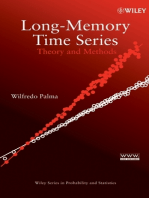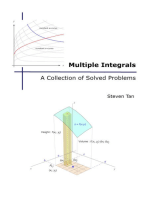Assignment 1
Uploaded by
aryan richhariyaAssignment 1
Uploaded by
aryan richhariyaVisvesvaraya National Institute of Technology, Nagpur
Department of Mathematics
Mathematics-I-MAL-101
Assignment-I
Topics: Limit, Continuity, Differentiability, Rolle’s Theorem and Lagrange’s Mean Value
Theorems.
√
3
1 + cx − 1
(1) Evaluate lim , where c is a constant.
x→0 x
(2) Using ϵ − δ definition show that
1
(i) lim (5x − 3) = 2, (ii) lim (4x − 5) = 7, (iii) lim x sin = 0.
x→1 x→3 x→0 x
√
(3) For the limit lim (x − 1) = 2, find a δ > 0 that works for ϵ = 1.
x→5
(4) Let f be continuous on the interval [a, b] and suppose that f (c) ̸= 0 for some c ∈ (a, b).
Show that there exists δ > 0 with the property that f (x) ̸= 0 for every x ∈ (c − δ, c + δ).
(5) Let f : [0, 1] → R be given by,
{
x , x is rational
f (x) =
x2 , x is irrational
Show that f is continuous at 0 and 1, but is not continuous at any point in (0, 1).
{
x2 sin( x1 ) for x ̸= 0,
(6) Show that the function f (x) = is differentiable at all x ∈ R.
0 for x = 0,
Also show that the function f ′ (x) is not continuous at x = 0. Thus, a function that is
differentiable at every point of R need not have a continuous derivative f ′ (x).
(7) Let K > 0 and let f : R → R satisfy the condition |f (x) − f (y)| ≤ K |x − y| for all
x, y ∈ R. Show that f (x) = sin x is continuous at every point c ∈ R.
(8) Let f (0) = 0 and f ′ (0) = 1. For positive integer k, show that
1{ (x) (x) ( x )} 1 1 1
lim f (x) + f +f + ..... + f = 1 + + + ....... + .
x→0 x 2 3 k 2 3 k
2
(9) Discuss the applicability of Rolle’s Theorem for the function f (x) = 1 − x 3 , on the
interval [−1, 1].
(10) Prove that the equation x3 + x − 1 = 0 has exactly one real root.
(11) Show that between any two roots of ex cos x − 1 = 0, there exists atleast one root of
ex sin x − 1 = 0.
(12) Suppose that f (0) = −3 and f ′ (x) ≤ 5 for all values of x. How large can f (2) possibly be?
(13) If f ′ (x) = 0 for all x in an interval (a, b), then show that f is constant on (a, b). Hence,
prove the identity tan−1 (x) + cot−1 (x) = π2 .
(14) Verify the function f (x) = x3 − x satisfies the hypotheses of the Mean value theorem
in [0, 2]. Then, find all the numbers c that satisfies the conclusion of the Mean Value
theorem.
You might also like
- 1 The Elements of Real Analysis Ed2 (1976) (Bartle) PDFNo ratings yet1 The Elements of Real Analysis Ed2 (1976) (Bartle) PDF494 pages
- Indian Institute of Technology Bhubaneswar School of Basic Sciences Mathematics-1 (MA1L001) (Autumn-2019) Assignment-1No ratings yetIndian Institute of Technology Bhubaneswar School of Basic Sciences Mathematics-1 (MA1L001) (Autumn-2019) Assignment-13 pages
- Question Bank (Single Variable Calculus)No ratings yetQuestion Bank (Single Variable Calculus)5 pages
- B.sc. (Hons.) III Mathematics-C.b.c.s.c5 Theory of Real Functions-2064No ratings yetB.sc. (Hons.) III Mathematics-C.b.c.s.c5 Theory of Real Functions-20644 pages
- Functions of One Real Variable - DPP 14 (Of Lec 19) - Saakaar Batch For IIT JAM MathematicsNo ratings yetFunctions of One Real Variable - DPP 14 (Of Lec 19) - Saakaar Batch For IIT JAM Mathematics6 pages
- Real Analysis Imp Questions - 240827 - 223420No ratings yetReal Analysis Imp Questions - 240827 - 2234204 pages
- Functions of One Real Variable - DPP 13 (Of Lec 18) - Saakaar Batch For IIT JAM MathematicsNo ratings yetFunctions of One Real Variable - DPP 13 (Of Lec 18) - Saakaar Batch For IIT JAM Mathematics6 pages
- Fermat's Theorem and The Mean Value Theorems: Aditya Ghosh Last Updated: Dec 01, 2020No ratings yetFermat's Theorem and The Mean Value Theorems: Aditya Ghosh Last Updated: Dec 01, 20203 pages
- Assignment 3: Derivatives, Maxima and Minima, Rolle's TheoremNo ratings yetAssignment 3: Derivatives, Maxima and Minima, Rolle's Theorem2 pages
- Function of A Real Variable: Zahmoul KhalilNo ratings yetFunction of A Real Variable: Zahmoul Khalil6 pages
- Assignment I: (To Be Submitted in Tutorial Class by September 13, 2019)No ratings yetAssignment I: (To Be Submitted in Tutorial Class by September 13, 2019)2 pages
- Limits, Continuity & Differentiability _ SBM __ Lakshya JEE AIR O1 (2026) (2)No ratings yetLimits, Continuity & Differentiability _ SBM __ Lakshya JEE AIR O1 (2026) (2)11 pages
- Solutions for Problems on Fermats Thm and the MvtsNo ratings yetSolutions for Problems on Fermats Thm and the Mvts11 pages
- (2)Mat101E_Limit_Continuity_2015_2016_fallNo ratings yet(2)Mat101E_Limit_Continuity_2015_2016_fall3 pages
- Assignment 3: Derivatives, Maxima and Minima, Rolle's TheoremNo ratings yetAssignment 3: Derivatives, Maxima and Minima, Rolle's Theorem1 page
- Hyperbolic Functions (Trigonometry) Mathematics E-Book For Public ExamsFrom EverandHyperbolic Functions (Trigonometry) Mathematics E-Book For Public ExamsNo ratings yet
- Assignment 4: Mean Value Theorem, Taylor's Theorem, Curve SketchingNo ratings yetAssignment 4: Mean Value Theorem, Taylor's Theorem, Curve Sketching2 pages
- Academic Regulations Course Structure AND Detailed Syllabus: Chemical EngineeringNo ratings yetAcademic Regulations Course Structure AND Detailed Syllabus: Chemical Engineering55 pages
- Witula R Hetmaniok E Slota D Mean-Value Theorems For One-Sided Differentiable FunctionsNo ratings yetWitula R Hetmaniok E Slota D Mean-Value Theorems For One-Sided Differentiable Functions10 pages
- MATH 1551 Section 4.2 (Part 2) Fall 2024 (Completed)No ratings yetMATH 1551 Section 4.2 (Part 2) Fall 2024 (Completed)28 pages
- TOEFL Beginner Math Second Midterm Revision SolutionsNo ratings yetTOEFL Beginner Math Second Midterm Revision Solutions4 pages
- C in (A, B) Such That FB Fa F C Ba: AP Calc Notes: DA2 - 2 Mean Value Theorem Mean Value Theorem (MVT)No ratings yetC in (A, B) Such That FB Fa F C Ba: AP Calc Notes: DA2 - 2 Mean Value Theorem Mean Value Theorem (MVT)3 pages
- MATH176 Blended 2T AY 2024-2025 SyllabusNo ratings yetMATH176 Blended 2T AY 2024-2025 Syllabus14 pages
- Far-Western University Faculty of Education B.Ed. in Mathematics EducationNo ratings yetFar-Western University Faculty of Education B.Ed. in Mathematics Education5 pages
- CLS JEEAD-18-19 XII Mat Target-6 SET-1 Chapter-5 PDFNo ratings yetCLS JEEAD-18-19 XII Mat Target-6 SET-1 Chapter-5 PDF36 pages
- Instant ebooks textbook Differential Calculus Booster with Problems and Solutions for IIT JEE Main and Advanced Rejaul Makshud McGraw Hill Rejaul Makshud download all chapters100% (1)Instant ebooks textbook Differential Calculus Booster with Problems and Solutions for IIT JEE Main and Advanced Rejaul Makshud McGraw Hill Rejaul Makshud download all chapters47 pages
- AP Calculus AB - Ultimate Guide Notes - KnowtNo ratings yetAP Calculus AB - Ultimate Guide Notes - Knowt29 pages
- Applications of Diferentiation: Using Differentials and DerivativesNo ratings yetApplications of Diferentiation: Using Differentials and Derivatives32 pages
- Mean Value Theorems For Vector Valued FunctionsNo ratings yetMean Value Theorems For Vector Valued Functions13 pages

























































































